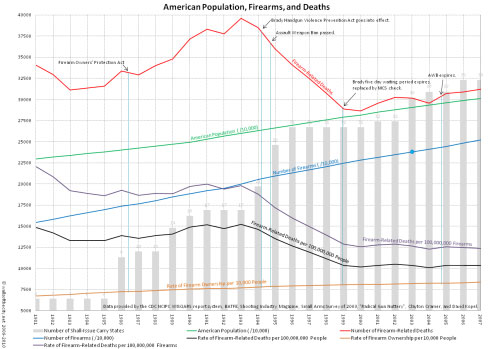 Linoge investigates the common assertion – HERE
Linoge investigates the common assertion – HERE
I still don’t know what to think. There are so many external variables involved when you’re dealing with guns and people, that I don’t like to be like the anti gun nuts (and the NRA on at least on occasion) and make statements about the correlation between guns and crime just to further promote my own views.



Comments
4 responses to “More Guns Equals Less Crime?”
To be fair, disproving “more guns = more deaths” does not necessarily prove “more guns = less deaths”. My goal was the former, and I dare say I managed it relatively well. The latter, as you indicate, will take a lot more analysis than I care to, and am probably able to, do.
Mike,
I’m a little confused about your statements. The graph has to do with fire arm related deaths and gun ownership. I don’t the article ever talks about crime. I don’t know, its a little early and i read it fast.
I agree with Phil that it’s a little confusing because the data isn’t trying to compare overall crime rates to the number of guns, it relates gun deaths. I agree with you that there are too many variables, and I have to disagree with Linoge when he says that he proved that more guns does not equate to more gun deaths – there are just too many other variables. What has been shown is that the trend in gun related deaths has not followed the upward trend in both population and number of firearms. I think the statement “more guns = more gun deaths” by itself is pretty innocent, pretty logical, and probably correct. It seems to imply that if all other variables remained unchanged that more guns would lead to more deaths; this seems naturally correct, like saying the more people that drive, the more automobile fatalities you’ll see.
I think what the data shows is that you can’t make a conclusion due to the other variables. Just looking at the graphs, you can see that there is no discernable relationship, and the very low coefficients of correlation confirm that. The graph of rate of firearms deaths to rate of firearm ownership shows an increased coefficient, but I don’t think that means a whole lot since the R² value means little if there are omitted variables that are affecting the data, as is the case here. As sort of a side note – I don’t think I like that column used in that graph – “Rate of firearm ownership per 10,000 people.” It implies, to me, that a rate of “x” means that x out of 10,000 people are firearm owners. What I think the actual data shows is that there are x number of firearms per 10,000 people – undoubtedly there are many firearm owners who own multiple firearms, so I think that’s a little misleading. The actual rate of firearm ownership, or number of firearm owners per 10,000 of population, is certainly much lower.
I think you just can’t draw conclusions about how the number of firearms relates to firearm deaths because of so many other variables. It’s a little unfortunate that it does, but the graph seems to support the claim that some of the laws that restrict gun ownership, or purchases, have had an effect on reducing the number of gun related deaths. It seems VERY apparent from the data that legislation has been a very important other variable that does not get accounted for when comparing number of deaths to number of firearms.
I think they’re pulling correlations out of nowhere, if you think about it, the firearms manufactured remain constant, no matter how many people die. So its going to go up no matter if it crime spikes or not. However, there seems to be a correlation between the AWB and the number of gun related deaths. I think that it just might mean that most firearm related deaths are people who are new to shooting and just purchase a rifle, and, sadly, disobey Jeff Cooper’s rules